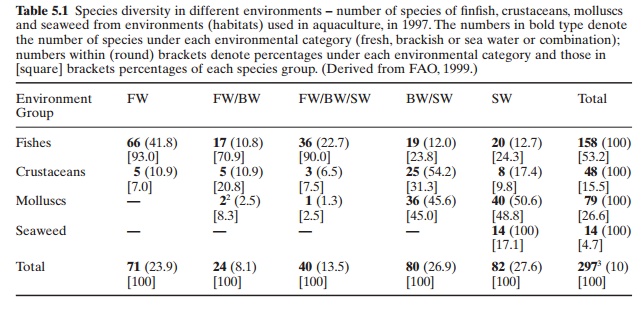Chapter: Aquaculture Principles and Practices: Selection of Species for Culture
Selection of Species for Culture
Selection of Species for Culture
Jhingran and Gopalakrishnan (1974) include about 465 species, belonging
to 28 families of plants and 107 families of animals, in a catalogue of
cultivated aquatic organisms. A more recent listing by the FAO (Garibaldi,
1996) and their annual production statistics indicate that there are about 300
farmed aquatic species. Out of a total of 297 farmed aquatic organisms in 1997,
71 were exclusively from fresh water and the rest were salt tolerant, including
82 exclusively from seawater (Kutty, 2001) (see Table 5.1). As can be expected,
the number of aquatic species under culture are increasing at a faster rate
with time as is evident from the species-wise statistics available from year to
year. It would probably be possible to culture almost all aquatic organisms,
but the main consideration is whether it is worth the effort and how far they can
contribute to the main objectives of aquaculture.

The availability of a large number of aquaculture species adapted to
different environmental conditions is an advantage, as it will often be
possible to choose from locally occurring species and avoid the introduction of
exotic ones for culture. For example, in Venezuela, species selection trials of
native Chachama (Colosoma macropomum),
a migratory characid, has enabled substitution of exotic tilapia and rainbow
trout to an extent (Jory etal.,
1999). However, this also means that aquaculture misses the advantages that
crop and animal production have had in agriculture where concentrated research
on a few species has led to the development of advanced technologies of
production and selected high-yielding strains and hybrids. It can, however, be
pointed out that in spite of the large number ofspecies involved in aquaculture
globally the number of species accounting for high production is small, as
indicated earlier (see Table 2.2). Only eight species yield over 1m tons
annually while 24 species yield over 100000 tons but less than 1m tons,
according to FAO aquaculture production data for 1997.
The history of agricultural research indicates that time and effort that
are needed to develop advanced production technologies. The science of
aquaculture (as distinct from traditional practices), which is relatively new,
will probably require a longer period of time to reach that level of
advancement if efforts have to be shared among so many species. It has to be remembered
that long traditional experience and scientific research have so far actually
succeeded in domesticating, in the sense of animal husbandry practices, only a
small number of species such as the trout, common carp and salmon. However, one
can clearly see a tendency towards limiting the number of species in
large-scale commercial aquaculture, whereas in aquaculture research an
increasing number of species are still being investigated. One has also to
consider the larger variety of genetically plastic aquatic species available to
meet the present and future needs of man, as well as the greater variability of
the site-specific aquatic environment compared to the terrestrial, in the
further diversification of species in aquaculture (EAS, 2001; Kutty, 2001).
Therefore the concentration of research efforts and developments of diversified
aquaculture systems may also become more restricted in a geographical context,
especially in a studying adaptive mechanisms of significance in site-specific
aquaculture.
Despite the value of limiting species for culture for speedy
technological advancement, it has to be recognized that there is a real need to
have species suited for different environmental conditions and economic
circumstances. Species have to be selected according to the objectives of
culture, for example increasing protein supplies to the poor, export to earn
foreign exchange or waste recycling in a poly-culture system.
Related Topics